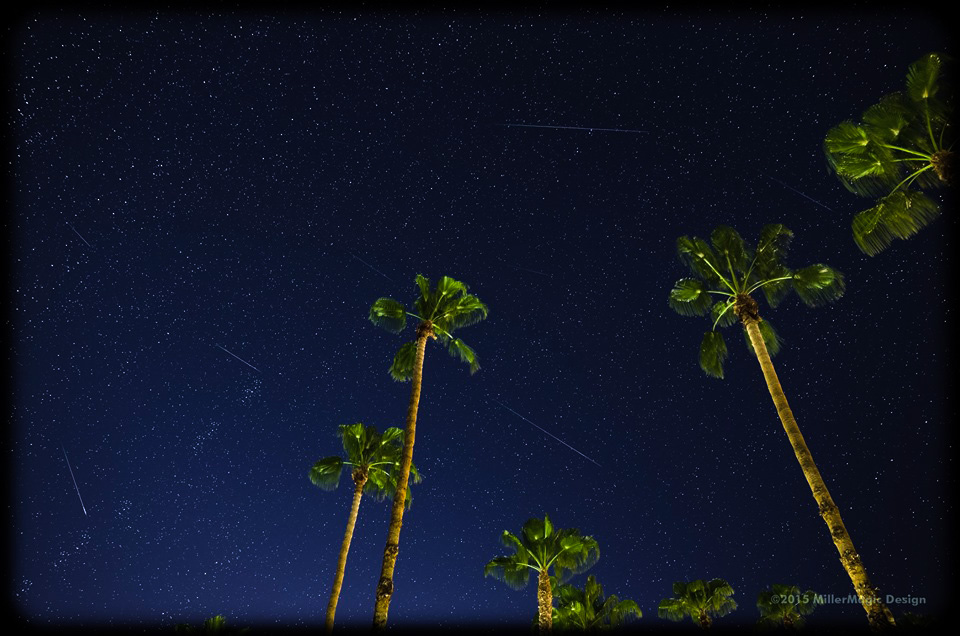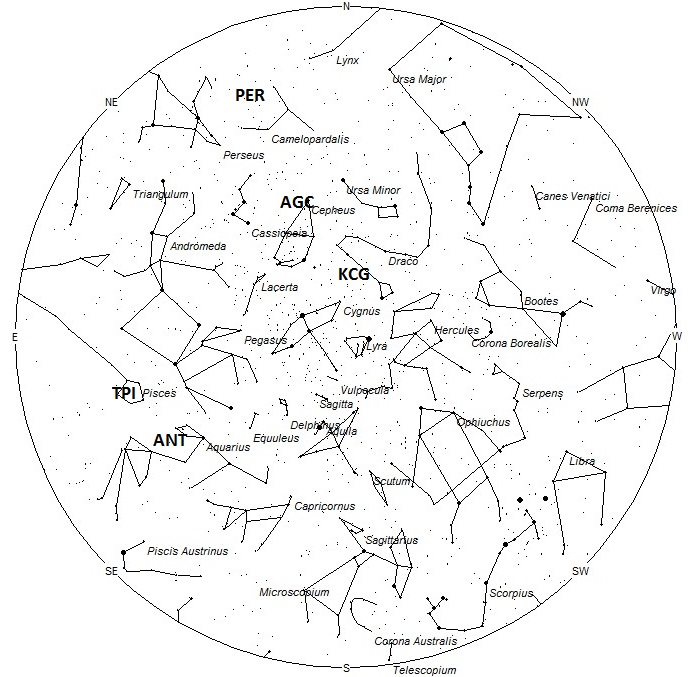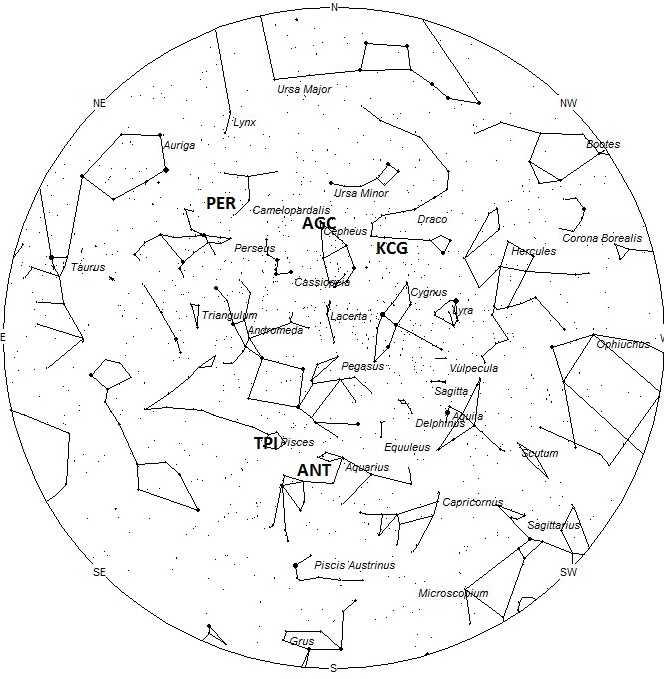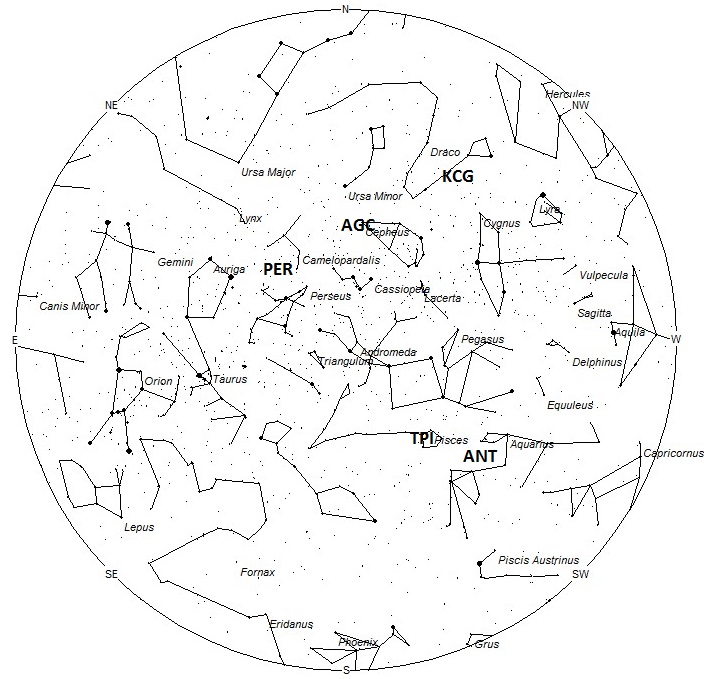
Perseid Meteors, Agust 12th 2015 (composite photo) – Palm Springs, CA, USA © Ken Miller
During this period the moon reaches its first quarter phase on Saturday August 22nd. The half-illuminated moon will set around midnight allowing unimpeded viewing of the morning sky when meteor activity is stronger. The moon will wax toward full and will set approximately 45 minutes later with each passing night. Toward the end of this period the moon will lie above the horizon most of the night making meteor observing difficult as the lunar glare will mask all but the brightest meteors. The estimated total hourly meteor rates for evening observers this week is near 3 as seen from mid-northern latitudes (45N) and 2 as seen from tropical southern locations (25S). For morning observers the estimated total hourly rates should be near 22 as seen from mid-northern latitudes (45N) and 13 as seen from tropical southern locations (25S). The actual rates will also depend on factors such as personal light and motion perception, local weather conditions, alertness and experience in watching meteor activity. Evening rates are reduced during this period by lunar glare. Note that the hourly rates listed below are estimates as viewed from dark sky sites away from urban light sources. Observers viewing from urban areas will see less activity as only the brightest meteors will be visible from such locations.
The radiant (the area of the sky where meteors appear to shoot from) positions and rates listed below are exact for Saturday night/Sunday morning August 22/23 These positions do not change greatly day to day so the listed coordinates may be used during this entire period. Most star atlases (available at science stores and planetariums) will provide maps with grid lines of the celestial coordinates so that you may find out exactly where these positions are located in the sky. A planisphere or computer planetarium program is also useful in showing the sky at any time of night on any date of the year. Activity from each radiant is best seen when it is positioned highest in the sky, either due north or south along the meridian, depending on your latitude. It must be remembered that meteor activity is rarely seen at the radiant position. Rather they shoot outwards from the radiant so it is best to center your field of view so that the radiant lies at the edge and not the center. Viewing there will allow you to easily trace the path of each meteor back to the radiant (if it is a shower member) or in another direction if it is a sporadic. Meteor activity is not seen from radiants that are located below the horizon. The positions below are listed in a west to east manner in order of right ascension (celestial longitude). The positions listed first are located further west therefore are accessible earlier in the night while those listed further down the list rise later in the night.
These sources of meteoric activity are expected to be active this week.
The Kappa Cygnids (KCG) were expected to peak on the August 18th. Activity will continue through the remainder of the month. The radiant is currently located at 18:16 (274) +61. This area of the sky is actually located in southern Draco, lying between the stars known as Aldib (Delta Draconis) and Eltanin (Gamma Draconis). These meteors are best seen as soon as it becomes dark in the evening hours. Rates are expected to be less than 1 per hour no matter your location. These meteors are not well seen from the southern hemisphere due to a low radiant altitude. With an entry velocity of 23 km/sec., the average Kappa Cygnid meteor would be of slow velocity.
The center of the large Anthelion (ANT) radiant is currently located at 22:48 (342) -05. This position lies in northern Aquarius just east of the faint star known as Kappa Aquarii. These meteors may be seen all night long but the radiant is best placed near 0200 local daylight saving time (LDT) when it lies on the meridian and is positioned highest in the sky. Due to the large radiant area, meteors from this source may also appear to radiate from western Pisces and southern Pegasus as well as Aquarius. Rates at this time should be near 2 per hour no matter your location. With an entry velocity of 30 km/sec., the average Anthelion meteor would be of slow velocity.
The Theta Piscids (TPI) are active from August 8 through September 1, with the peak falling on August 20th. These meteors have a radiant currently located at 23:37 (354) +05. This area of the sky is located in western Pisces, just south of the faint star known as Iota Piscium. The radiant is best placed near 0300 LDT, when it lies highest in the sky. Rates are expected to be near 1 per hour no matter your location. With an entry velocity of 39 km/sec., most activity from this radiant would be of average velocities. After a recent discussion with Sirko Molau concerning this radiant, it seems that the TPI’s are actually the late part of the Northern Delta Aquariids. So next year this source will most likely be incorporated into the NDA’s.
The August Gamma Cepheids (AGC) were first noticed by members of the Croatian Meteor Network using their video data and that of SonotaCo. This source is active from August 22nd through September 1st with maximum activity occurring on August 28th. The current radiant position lies at 23:58 (000) +77. This area of the sky lies in northern Cepheus, just east of the 3rd magnitude star known as Errai (Gamma Cephei). Current rates would be less than 1 per hour no matter your location. This radiant is poorly placed for viewing south of the equator so very little activity is likely to be seen from the southern hemisphere. With an entry velocity of 41 km/sec., the average meteor from this source would be of medium velocity.
The Perseids (PER) are now producing just a small fraction of the activity that was witnessed last week. This weekend the radiant will be located at 04:04 (061) +60. This area of the sky actually lies in southern Camelopardalis, 12 degrees northeast of the 2nd magnitude star known as Mirfak (Alpha Persei). This area of the sky is best seen during the last hour before dawn when the radiant lies highest above the horizon in a dark sky. Rates this weekend (at 4am local daylight saving time) are expected to be near 5 per hour as seen from the northern hemisphere and 1 per hour as seen from south of the equator. Rates seen earlier in the night will be less. With an entry velocity of 61 km/sec., the average Perseid meteor would be of swift speed.
As seen from the mid-northern hemisphere (45N) one would expect to see approximately 14 sporadic meteors per hour during the last hour before dawn as seen from rural observing sites. Evening rates would be near 2 per hour. As seen from the tropical southern latitudes (25S), morning rates would be near 9 per hour as seen from rural observing sites and 1 per hour during the evening hours. Locations between these two extremes would see activity between the listed figures.
The table below presents a list of radiants that are expected to be active this week. Rates and positions are exact for Saturday night/Sunday morning except where noted in the shower descriptions.
| SHOWER | DATE OF MAXIMUM ACTIVITY | CELESTIAL POSITION | ENTRY VELOCITY | CULMINATION | HOURLY RATE | CLASS |
| RA (RA in Deg.) DEC | Km/Sec | Local Daylight Saving Time | North-South | |||
| Kappa Cygnids (KCG) | Aug 18 | 18:16 (274) +61 | 23 | 23:00 | <1 – <1 | II |
| Anthelions (ANT) | – | 22:48 (342) -05 | 29 | 02:00 | 2 – 2 | II |
| Theta Piscids (TPI) | Aug 20 | 23:37 (354) +05 | 39 | 03:00 | 1 – 1 | IV |
| August Gamma Cepheids (AGC) | Aug 28 | 23:58 (000) +77 | 41 | 03:00 | <1 – <1 | IV |
| Perseids (PER) | Aug 13 | 04:04 (061) +60 | 61 | 06:00 | 5 – 1 | I |
 American Meteor Society
American Meteor Society



I just saw my very first very large meteor – I think. I live in Estes Park, Colorado and it was at about 2:38am on Sunday August 22, 2015. I had no clue what it was until I came inside and got online. Sure enough, I found exactly what I saw. Awesomer
I think I saw one just before 6:30 in Mesa, Az. It was bright blue and I could see it for a few seconds. Can this be confirmed by anyone?
Bonnie,
There are 3 other witnesses to your fireball. You can read summaries of their reports at: http://www.amsmeteors.org/members/imo_view/event/2015/2074
I invite you to submit your own report at: http://www.amsmeteors.org/members/imo/report_intro
Thanks!
Robert Lunsford
I just saw a cluster of debris, about a dozen pieces, which could have been one shooting star breaking up or several distinct shooting stars moving fairly slow, horizontally across the sky. The objects were moving slow enough, and stayed visible long enough, that my husband and I were able to pull over, get out of the car and watch for about 10 – 12 seconds until it disappeared behind some clouds. St. Louis Heights Honolulu, Hawaii, August 30, 2015; 11:25pm-ish. Did anyone else witness this???